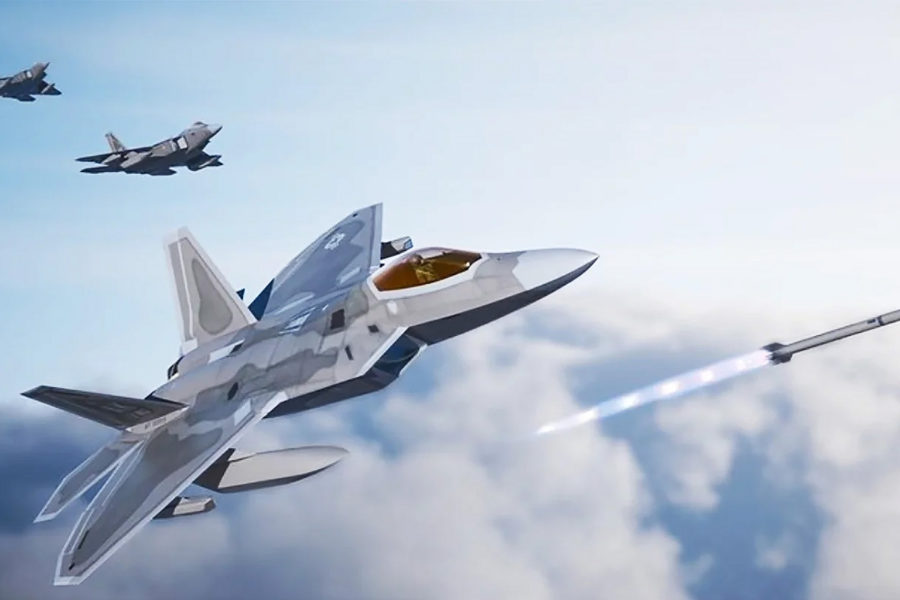DAYTON, Ohio—The low-drag, stealthy fuel tanks and pylons Lockheed Martin is developing for the F-22 are potentially applicable to other aircraft like the F-35, the head of Lockheed’s Integrated Fighter Group told Air & Space Forces Magazine.
Lockheed executive O.J. Sanchez and the Air Force’s director of fighters and advanced aircraft also said the Air Force’s hefty investments in F-22 capabilities over the next seven years will migrate to the Next Generation Air Dominance program and other platforms and won’t go to waste when the F-22 retires.
“There is an applicability” of the low-drag tanks and other capabilities being developed for the F-22 to the F-35 and other aircraft, said Sanchez, vice president and general manager of Lockheed’s integrated fighter group, who oversees the F-22, F-16, and T-50.
Sanchez does not speak for the F-35 program and did not specify that platform as a confirmed user of the F-22 upgrade technologies.
Speaking at the Air Force’s Life Cycle Industry Days conference, Sanchez said, “That really is the kind of thinking that we talk about every day as an industry partner; is, ‘how do we do this integration work the best we can so that there’s opportunities for reuse on other platforms?’”
In its fiscal 2024 budget documents, the Air Force said the long-range tanks, which can be jettisoned, will give the F-22 a much-needed range boost in the Pacific theater. They presumably could do the same for the F-35, while simultaneously reducing the burden on aerial tankers. Stealth tanks and pylons for the F-35 would need specific design, however, to harmonize with the aircraft’s stealth shaping.
The F-35 Joint Program Office did not immediately respond to queries about potential stealth fuel tanks for the F-35.
Sanchez could not characterize the degree of cross-pollination between F-22 and F-35 but said that Lockheed is “looking across … the airpower solutions, and if there is an applicability [on another platform], we will do everything we can to build that capability in.” The Air Force’s program offices can then decide whether they want that capability, he said.
The Air Force is on the cusp of deploying the stealthy fuel tanks, an infrared search-and-track system, and other capabilities on the F-22 that will allow it to “go further, sense further and shoot further,” Sanchez said. That’s the Air Force’s vision for the F-22’s remaining service life and “we’re aligned with that and we’re going to do all we can to help bring those visions to reality,” he said.
The Air Force plans to upgrade the F-22 to keep up with adversary capabilities through around 2030, at which time the NGAD is expected to begin replacing it. The Air Force’s fiscal 2024 budget request forecasts spending $9.06 billion on new capabilities for the F-22 through 2030, on top of the cost of operating the fleet.
The F-22 is also the threshold platform for the AIM-260 Joint Advanced Tactical Missile, about which conference panelists would say little. The missile’s existence was revealed at the conference in 2019, at which time it was forecast the JATM would be operational in 2022 or 2023. The Air Force has only acknowledged that testing is underway.
Brig. Gen. (Maj. Gen. Select) Dale White, program executive officer for fighters and advanced aircraft, said the Air Force plans to keep the F-22 at the cutting edge of air-to-air technology through its remaining service life, and that it will serve as a technological “bridge” to the NGAD.
“We continue to modernize and sustain” the Raptor, White told reporters at the conference. He noted improvements such as the infrared search-and-track system, “advanced weapons, extended range capabilities, Link 16, Mode 5 IFF (Identification Friend or Foe), resilient [navigation], low drag tanks and pylons; all those things are still a key focus.”
White said “we’re making tremendous progress on all those capabilities” on a fighter modernization roadmap that will “address the requirements of today and that bridge” to NGAD.
White also noted that the F-22 and NGAD will fly together in a combined test force at Edwards Air Force Base, Calif., the better to practice the techniques, tactics, and procedures necessary to achieve air superiority.
Asked to explain why the Air Force should continue to lay out huge sums for F-22 modernization when it will retire in just over seven years, White said “you can’t turn your back on the threat.”
“The threat gets a vote,” he added. “And so we have to focus on that, making sure we have the capability to address today’s requirements. And then, as we work on future activities, it’s tomorrow’s threats.”
The technologies that go into the Raptor’s modernization will also apply across the portfolio, he said.
“To assume that things that what I do on F-22 won’t feed into the technology maturation or future capabilities; that’s … probably a bad assumption,” he said. Lessons learned on preserving the F-22’s edge will apply to other platforms, if not the “specific” hardware, he said. These include the IRST, electronic warfare, and other capabilities, he added, noting that such capabilities could apply to non-tactical air programs as well.
“At the end of the day, we still have a threat we have to address now,” White insisted. “The F-22 represents our ability to address that threat and it will continue to be the bridge to NGAD, and in order to do that, we have to keep it modernized; we have to keep it lethal and operationally viable.”


